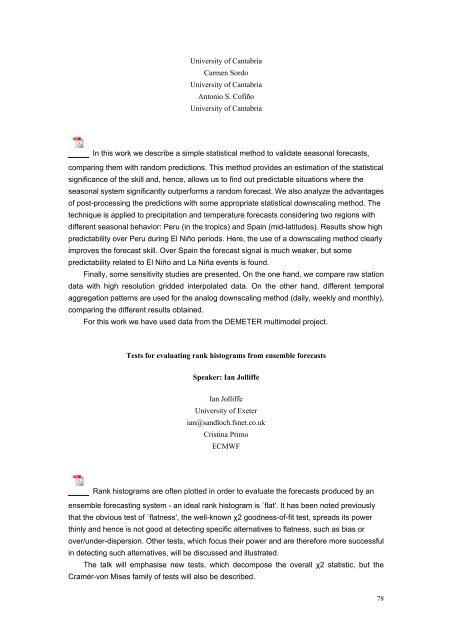The tenth IMSC, Beijing, China, 2007 - International Meetings on ...
The tenth IMSC, Beijing, China, 2007 - International Meetings on ...
The tenth IMSC, Beijing, China, 2007 - International Meetings on ...
You also want an ePaper? Increase the reach of your titles
YUMPU automatically turns print PDFs into web optimized ePapers that Google loves.
University of Cantabria<br />
Carmen Sordo<br />
University of Cantabria<br />
Ant<strong>on</strong>io S. Cofiño<br />
University of Cantabria<br />
In this work we describe a simple statistical method to validate seas<strong>on</strong>al forecasts,<br />
comparing them with random predicti<strong>on</strong>s. This method provides an estimati<strong>on</strong> of the statistical<br />
significance of the skill and, hence, allows us to find out predictable situati<strong>on</strong>s where the<br />
seas<strong>on</strong>al system significantly outperforms a random forecast. We also analyze the advantages<br />
of post-processing the predicti<strong>on</strong>s with some appropriate statistical downscaling method. <str<strong>on</strong>g>The</str<strong>on</strong>g><br />
technique is applied to precipitati<strong>on</strong> and temperature forecasts c<strong>on</strong>sidering two regi<strong>on</strong>s with<br />
different seas<strong>on</strong>al behavior: Peru (in the tropics) and Spain (mid-latitudes). Results show high<br />
predictability over Peru during El Niño periods. Here, the use of a downscaling method clearly<br />
improves the forecast skill. Over Spain the forecast signal is much weaker, but some<br />
predictability related to El Niño and La Niña events is found.<br />
Finally, some sensitivity studies are presented. On the <strong>on</strong>e hand, we compare raw stati<strong>on</strong><br />
data with high resoluti<strong>on</strong> gridded interpolated data. On the other hand, different temporal<br />
aggregati<strong>on</strong> patterns are used for the analog downscaling method (daily, weekly and m<strong>on</strong>thly),<br />
comparing the different results obtained.<br />
For this work we have used data from the DEMETER multimodel project.<br />
Tests for evaluating rank histograms from ensemble forecasts<br />
Speaker: Ian Jolliffe<br />
Ian Jolliffe<br />
University of Exeter<br />
ian@sandloch.fsnet.co.uk<br />
Cristina Primo<br />
ECMWF<br />
Rank histograms are often plotted in order to evaluate the forecasts produced by an<br />
ensemble forecasting system - an ideal rank histogram is `flat'. It has been noted previously<br />
that the obvious test of `flatness', the well-known χ2 goodness-of-fit test, spreads its power<br />
thinly and hence is not good at detecting specific alternatives to flatness, such as bias or<br />
over/under-dispersi<strong>on</strong>. Other tests, which focus their power and are therefore more successful<br />
in detecting such alternatives, will be discussed and illustrated.<br />
<str<strong>on</strong>g>The</str<strong>on</strong>g> talk will emphasise new tests, which decompose the overall χ2 statistic, but the<br />
Cramér-v<strong>on</strong> Mises family of tests will also be described.<br />
78






![final_program_abstracts[1]](https://img.yumpu.com/19102520/1/174x260/final-program-abstracts1.jpg?quality=85)









